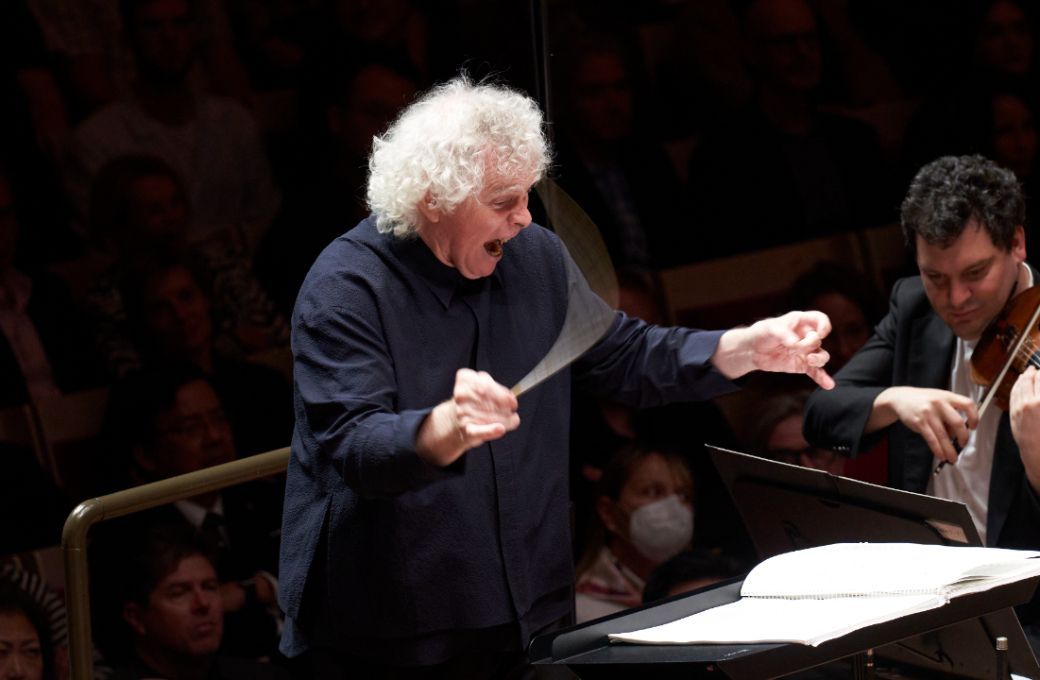With the visit of the London Symphony Orchestra to the Sydney Opera House this week, there is a sense of finally shutting the door on the disruptions of the last few years. For the first time since the pandemic, an overseas orchestra has graced the building, and the atmosphere for the opening concert was appropriately festal, with party streamers distributed to those sitting near the stage among the capacity crowd. So confident were the organisers in the star power of the LSO and their Music Director Sir Simon Rattle that all three programmes are being simultaneously broadcast to the forecourt outside the Opera House, so that many others can experience the music for a fraction of the cost.
This is not the first visit to Sydney for either conductor or orchestra, but in the interim the interior of the Concert Hall has been renovated and acoustically much improved, as Rattle acknowledged in his brief post-concert remarks. The increased audibility of individual parts was crucial to the effectiveness of the first programme, focussed on French impressionism and John Adams’ sonically dense Harmonielehre. These were preceded by Deborah Cheetham Fraillon’s Tarimi Nulay, a sung acknowledgement of country which required the cooperation of Sydney Philharmonia Symphony Chorus, all 170 or so members singing from memory.
The choir were thereafter spectators until the final piece, as the orchestra unleashed the battery of sound that begins Harmonielehre. Throughout the first movement, one was left marvelling at Adams’ mesmeric play of motions, so much more audible live than on even the best of recordings. From my seat near the front, it was fascinating seeing up close the phase-shifting among the first violins, with each desk offset a fraction from the others. Also admirable was the strong sense of an overall plan Rattle conveyed in a work which in lesser hands can descend into shapelessness; one was led through the kaleidoscopic textures with sureness and purpose.

In the second movement, The Anfortas Wound, the music reached an almost unbearable level of intensity at the climax through the combination of volume, register and dissonance, but the orchestra distinguished itself just as much in the beautifully soft ending. Rattle marshalled his enormous forces without a wasted gesture, but could still be very vigorous when it was needed, such as when cueing the multiple tricky entries in the final movement, Meister Eckhardt and Quackie.
Debussy’s La Mer was paired with the second suite from Ravel’s Daphnis et Chloé for a second half rich in colour. Whether it was the pellucid opening textures, the passionate cello ensemble in the first sketch, the delicatissimo ending of the second, or the rounded tone of the woodwind melody in the third, the orchestra impressed throughout La Mer. As one would expect of a leading orchestra, there was a strong sense of layered textures rather than homogeneous dynamics across the forces, giving welcome light and shade, and allowing individual instruments to come to the fore. The diaphanous textures of the Ravel took on a transparency, allowing us to marvel at the virtuosity of the flutes and strings as one was able to hear the sheer number of notes they rippled through, seemingly without effort. With the choir singing their descending moans with gusto, the final Danse générale culminated in an outburst of corybantic rapture.
Rattle then deliberately lowered the temperature with Delius’ Intermezzo from Fennimore and Gerda, memorable for delightful woodwind solos over pastoral sonorities. The second encore was an extremely brisk final Fugue from The Young Person’s Guide to the Orchestra, allowing each orchestral section its well-deserved moment in the sun.


